| Regions of the Republic of Artsakh Շրջանները Արցախի Հանրապետության (Shrjannerë Arts’akhi Hanrapetut’yan) (Armenian) | |
|---|---|
 Provinces of the Republic of Artsakh. Solid colors: Soviet-era NKAO controlled by Artsakh from 2020–23; horizontal stripes: Azerbaijani-ruled, claimed by Artsakh | |
| Category | Unitary state |
| Location | Artsakh |
| Number | 6 provinces 1 special status city |
| Populations | 2,560 (Shahumyan) – 49,986 (Stepanakert) |
| Areas | 26 km2 (9.9 sq mi) (Stepanakert) – 3,380 km2 (1,304 sq mi) (Kashatagh) |
| Government |
|
| Subdivisions |
|
The administrative divisions of the Republic of Artsakh were of two types; provinces and cities. There were six provinces and one special administrative city (the capital of the Republic, Stepanakert).[1]
Municipalities in Artsakh were divided into 2 categories: urban communities and rural communities. Before the 2020 war, there were 10 towns (urban) and 322 villages (rural) in Artsakh.[2]
Administrative divisions
These divisions included territories never controlled by the Republic of Artsakh. They were officially considered occupied by Azerbaijan.[3]
| Province | Population (2005 census)[4] |
Area (km2) | Capital | Map |
|---|---|---|---|---|
| 1 Martakert Province | 18,963 | 1,795 | Martakert | 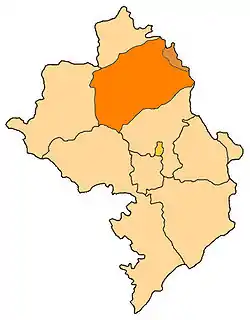 |
| 2 Askeran Province | 16,979 | 1,222 | Askeran | 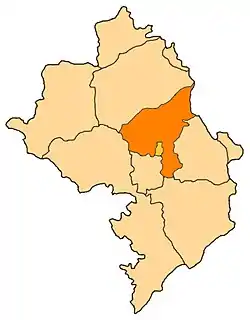 |
| 3 Stepanakert | 49,986 | 25.66 | Stepanakert | 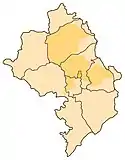 |
| 4 Martuni Province | 23,158 | 951 | Martuni | 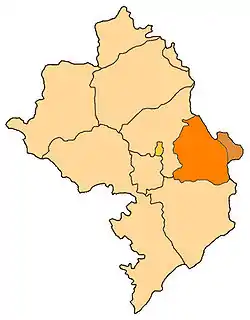 |
| 5 Shushi Province | 4,324 | 383 | Shushi | 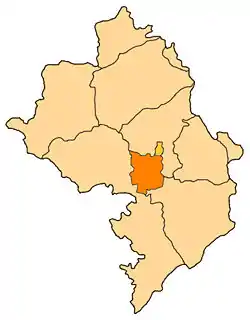 |
| 6 Hadrut Province | 12,005 | 1,877 | Hadrut | 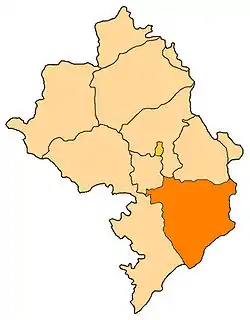 |
| 7 Shahumyan Province | 2,560 | 1,830 | Karvachar | 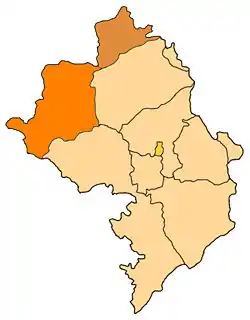 |
| 8 Kashatagh Province | 9,763 | 3,377 | Berdzor |  |
Azerbaijan divisions and claimed territories

Before the Artsakh republic was established, the territory was organized by the Republic of Azerbaijan into a number of rayons (districts). Artsakh extended its provinces across the border of the former Nagorno-Karabakh Autonomous Oblast (NKAO), removing the administrative distinction between the two areas.[5] The following districts, which were not part of the NKAO but were in Azerbaijan proper, were completely within the de facto borders of Artsakh before the 2020 Nagorno-Karabakh war: Lachin, Qubadli, Zangilan, Jabrayil, Kalbajar. Additionally, parts of the following districts were partly under the control of Artsakh: Agdam District and Fuzuli District.
| Former Nagorno-Karabakh Autonomous Oblast | |||
|---|---|---|---|
| District (Rayon) | Area (km2) | Under NKR control (km2) | % |
| Askeran District | 928 | 860 | 93 |
| Hadrut District | 679 | 0 | 0 |
| Mardakert District | 1,705 | 1,475 | 87 |
| Martuni District | 792 | 447 | 56 |
| Shusha District | 280 | 169 | 60 |
| NKAO | 4,384 | 2,951 | 67 |
Pre-2020 war

1: Martakert; 2: Askeran; 3: Stepanakert (city); 4: Martuni; 5: Shushi; 6: Hadrut; 7: Shahumyan; 8: Kashatagh
(Vertical dashed lines indicate territory outside of the former Nagorno-Karabakh Autonomous Oblast and Shahumyan Region. Horizontal dashed lines indicate territory under the control of Azerbaijan before the war.)
Before the 2020 Nagorno-Karabakh war, there were seven provinces. The districts of Azerbaijan surrounding Nagorno-Karabakh that were administered by Artsakh were: Lachin District, Qubadli District, Zangilan District, Jabrayil District and Kalbajar District, as well as parts of Agdam, and Fuzuli District. On the other hand, the eastern ends of Martakert and Martuni were under Azerbaijani control.
| Former Nagorno-Karabakh Autonomous Oblast | |||
|---|---|---|---|
| District (Rayon) | Area (km2) | Under NKR control (km2) | % |
| Askeran District | 928 | 928 | 100 |
| Hadrut District | 679 | 679 | 100 |
| Mardakert District | 1,705 | 1,571 | 92 |
| Martuni District | 792 | 632 | 80 |
| Shusha District | 280 | 280 | 100 |
| NKAO | 4,384 | 4.090 | 93 |
| Rayons of Azerbaijan SSR other than in NKAO | |||
| Southern part of Goranboy District | 558 | 0 | 0 |
| Kalbajar District | 1,936 | 1,936 | 100 |
| Lachin District | 1,835 | 1,835 | 100 |
| Qubadli District | 802 | 802 | 100 |
| Zangilan District | 707 | 707 | 100 |
| Jabrayil District | 1,050 | 1,050 | 100 |
| Fuzuli District | 1,390 | 462 | 33.2 |
| Agdam District | 1,150 | 842 | 73.2 |
| Azerbaijan | 8,870 | 7,634 | 86.1 |
See also
References
- ↑ NKR regions
- ↑ Administrative Territorial System of the Nagorno Karabagh Republic
- ↑ Siranush Ghazanchyan (1 February 2022). "Bill on territories occupied by Azerbaijan brought to the agenda of Artsakh Parliament". Public Radio of Armenia. Retrieved 2 February 2022.
- ↑ NKR official census of 2005
- ↑ Toal, Gerard; O'Loughlin, John (5 November 2013). "Land for Peace in Nagorny Karabakh? Political Geographies and Public Attitudes Inside a Contested De Facto State". Territory, Politics, Governance. 1 (2): 158–182. doi:10.1080/21622671.2013.842184. S2CID 54576963. Retrieved 27 November 2020.